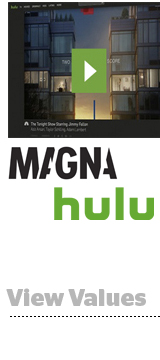 As it turns out, a smaller screen size may be more effective at driving purchase intent than larger devices in the living room.
As it turns out, a smaller screen size may be more effective at driving purchase intent than larger devices in the living room.
Hulu and Magna have released new data assessing the impact of video ad exposures in different channels on overall effectiveness.
They found ads on over-the-top (OTT) devices aided the most in brand awareness at 15% lift (versus 8.6% lift for mobile). Meanwhile, mobile performed better on purchase intent, delivering a 12.7% lift versus 8% in OTT.
“Consumers often check prices on their phone, and it’s the device they have with them more often, so it made sense that the phone would be the device that gets you further along the purchase funnel,” said Brian Hughes, SVP of audience intelligence and strategy at Magna.
And although it seems like a no-brainer that brand awareness and recall would increase with the larger screen real estate afforded by OTT, Hughes suggested consumers may be more receptive to brand messaging there in the first place.
“On-demand environments are more conducive to consumer attention because they’ve chosen the time and place they want to watch,” Hughes said, as opposed to mobile, which is much more of a personal device and utility.
Magna also wanted to assess cross-platform message sequencing. Over the course of two months, the companies measured the effect of the number of exposures (one, two to four, five to eight and nine-plus) on awareness, purchase intent and brand favorability.
The research suggests that on OTT devices, brand favorability increased slightly more at nine-plus exposures (64%) than it did at two to four exposures (60%), indicating that if messages are paced thoughtfully, a brand could stay top of mind at a higher frequency without oversaturating the consumer.
Hulu worked with Magna, Interpublic Group’s strategic investment arm, and Kantar Millward Brown to measure 10 advertiser campaigns between Q2 and Q3 to understand how mobile and over-the-top TV ads complement (and differ from) one another.
Hulu and Millward used a range of control tests, isolating ad exposures on PC, mobile and OTT, and measuring the percentage lift in aided awareness, online aided awareness, brand favorability and purchase intent within each channel and overall.
Although Hulu had conducted ad effectiveness research for years on desktop, standard measurement didn’t factor in that more than 70% of Hulu viewing now happens on living room devices like game consoles and connected and smart TVs.
Hulu already augments Nielsen and comScore for third-party measurement, but it increasingly found marketers preferred deeper metrics around purchase intent and recall to proxies like views or completions.












